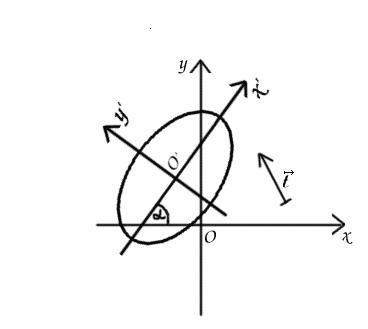Matrix representation of conic sections
|
|
In mathematics, the matrix representation of conic sections is one way of studying a conic section, its axis, vertices, foci, tangents, and the relative position of a given point. We can also study conic sections whose axes aren't parallel to our coordinate system.
Conic sections have the form of a second-degree polynomial:
- <math>
Q \equiv Ax^2+By^2+Cx+Dy+Exy+F=0 <math>
That can be written as:
- <math>
\mathbf{x}^T A_Q\mathbf{x}=0 <math>
Where <math>\mathbf{x}<math> is the vector:
- <math>
\begin{pmatrix} 1 \\ x \\ y \end{pmatrix} <math>
And <math>A_Q<math> a matrix:
- <math>
A_Q = \begin{pmatrix} F & C/2 & D/2 \\ C/2 & A & E/2 \\ D/2 & E/2 & B \end{pmatrix} <math>
| Contents |
Classification
Regular and degenerated conic sections can be distinguished based on the determinant of AQ.
Iff <math>|A_Q| = 0<math>, the conic is degenerate.
If Q isn't degenerate, we can see what type of conic section it is by computing the subdeterminant resulting from removing the first row and the first column of AQ (ie the minor A11).
- <math>
A_{11} =
\begin{pmatrix}
A & E/2 \\
E/2 & B
\end{pmatrix}
<math>
- Iff <math> |A_{11}| < 0 <math>, it is a hyperbola.
- Iff <math> |A_{11}| = 0 <math>, it is a parabola.
- Iff <math> |A_{11}| > 0 <math>, it is an ellipse.
In the case of an ellipse, we can make a further distinction between an ellipse and a circle by comparing the last two diagonal elements corresponding to x2 and y2.
- If <math>a_{11} = a_{22}<math>, it is a circle.
If the conic section is degenerate (<math>|A_Q| = 0<math>), <math>|A_{11}|<math> still allows us to distinguish its form:
- Iff <math> |A_{11}| < 0 <math>, it is two intersecting lines.
- Iff <math> |A_{11}| = 0 <math>, it is two (possibly coincident) parallel straight lines.
- Iff <math> |A_{11}| > 0 <math>, it is empty.
Center
We can calculate the center by taking the last two rows of the associated matrix, set them equal to 0 and solve the system.
- <math>
S \equiv
\left\{ \begin{matrix}
a_{21} + a_{22}x + a_{23}y & = & 0 \\
a_{31} + a_{32}x + a_{33}y & = & 0
\end{matrix} \right. \equiv
\left\{\begin{matrix}
C/2 + Ax + (E/2)y & = & 0 \\
D/2 + (E/2)x + By & = & 0
\end{matrix} \right.
<math>
Axes
The major and minor axes are two lines determined by the center of the conic as a point and eigenvectors of the associated matrix as vectors of direction.
- <math>
a_{1,2} \equiv
\left\{\begin{matrix}
S(x_0,y_0) &\qquad \mbox{(center of the conic)}\\
\vec u(u_x,u_y) &\qquad \mbox{(eigenvector of A)}
\end{matrix} \right.
<math>
So we can write a canonical equation:
- <math>
a_{1,2} \equiv \frac{x-x_0}{u_x} = \frac{y-y_0}{u_y} <math>
Because a 2x2 matrix has 2 eigenvectors, we obtain 2 axes.
Vertices
For a general conic we can determine its vertices by calculating the intersection of the conic and its axes — in other words, by solving the system:
- <math>
V \equiv
\left\{\begin{matrix}
& e &\qquad \mbox{(axis)} \\
& Q &\qquad \mbox{(the general equation of the conic)}
\end{matrix} \right.
<math>
Reduced equation
The reduced equation of a conic section is the equation of a conic section translated and rotated so that its center lies in the center of the coordinate system and its axes are parallel to the coordinate axes. This is equivalent to saying that the coordinates are moved to satisfy these properties. See the figure.
If <math>\lambda_1<math> and <math>\lambda_2<math> are the eigenvalues of the matrix A, the reduced equation can be written as:
- <math>
\lambda_1 x'^2 + \lambda_2 y'^2 + \frac{|A|}{|A_{00}|} = 0 <math>
Dividing between <math>-\frac{|A|}{|A_{00}|}<math> we obtain a reduced canonical equation. For example, for an ellipse:
- <math>
\frac{{x'}^2}{a^2} + \frac{{y'}^2}{b^2} = 1 <math>
From here we get 'a' and 'b'.
The transformation of coordinates is given by:
- <math>
T: RS(O,X,Y) -> (O'=S,X',Y') \equiv
\left\{\begin{matrix}
\vec t &=& \vec OO' = S\\
\alpha &=& \operatorname{acos} \frac{\vec a_1 \cdot {1 \choose 0}}{|\vec a_1|}
\end{matrix} \right.
<math>

